Ever wondered what makes the skin of a person oilier than others? It is the Sebaceous Gland that are responsible for the greasiness of the skin. Read on to know all about Sebaceous Glands.
What are Sebaceous Glands?
Page Contents
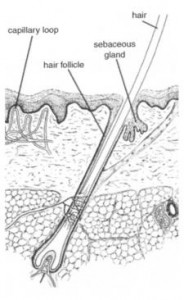
Picture 1 – Sebaceous Gland Picture
Source – skintactix
Sebaceous Glands are very small glands in the skin that are only visible under the microscope. The glands are responsible for depositing an oily secretion on the hairs called sebum.
Where are Sebaceous Glands Located?
Sebaceous Glands can be found in all parts of the skin in the human body except soles and palms. These glands are generally located in the hairy parts of the body. These are connected to the hair follicles over the skin.
The gland can also be found in non-hairy regions of the skin, such as the eyes, nipples, Labia Minora, penis and nose.
Approximately 3 thousand Sebaceous Glands can be found per square inch of the skin. These glands are primarily found on areas like the face, scalp, chest and back. These mature and start active production of sebum when there is an onset of puberty in the person.
Sebaceous Glands on Penis
Sebaceous Glands on penis appear yellow or off-white in color. These are very small but can be seen because the penis tissues are very thin. The penis Sebaceous Glands are more noticeable in some persons than others. A few people view this as an abnormal condition and try to remove the glands by poking them. This should never be done for squeezing and poking may lead to an infected Sebaceous Gland.
Infected or blocked Sebaceous Glands of the penis can give rise to inflammation. Antibiotics are the medicines generally used for swollen penis Sebaceous Glands treatment. Patients should not try to break open the infected gland for it may spread the infection to other glands as well.
It is essential to maintain proper hygiene to prevent Sebaceous Gland infection of penis. Using your own clean towels, not sharing other’s undergarments and throwing away razors used for shaving the genital region should be practiced for prevention of Penis Sebaceous Gland infection.
Sebaceous Gland Function
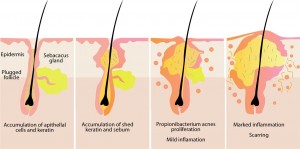
Picture 2 – Sebaceous Gland
Source – indianwomenshealth
Protecting the skin is the main function of Sebaceous Glands. Sebaceous Glands secrete an oily substance known as Sebum that lubricates the hair and skin of mammals. Large quantities of sebum protect skin and hair from water. It reduces the growth of microorganisms anywhere on the skin.
It is only because of the sebum that people can experience a wet skin even when they have not taken bath for days.
What is Sebum?
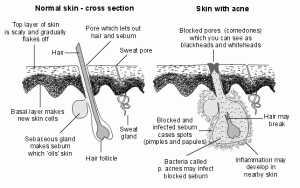
Picture 3 – Sebum Picture
Source – patient
“Sebum” is the Latin word for “fat”. It is the oily secretion of the Sebaceous Glands which keeps the hair and skin moisturized and prevents them from cracking, turning dry and getting brittle.
The sebum comprises of lipids, wax and clusters of dead fat-producing cells. The percentage breakup of the composition of sebum shows it to be comprised of
- Triglycerides – 40%
- Wax monoesters – 25%
- Free fatty acids – 16%
- Squalene – 12%
Sebum is created in the Sebaceous glands. Following production, this oily substance is secreted through a small duct. From the gland it moves up the hair shaft and ultimately arises to the skin surface through the hair follicle. While coming up, it helps to push out any dust particle, germs or skin debris that may have somehow entered into the hair follicle.
It is because of Sebaceous Glands hair follicles remain free from foreign objects. The sebaceous glands can also come over the skin surface because of the follicles. Hair follicles and Sebaceous Sweat Glands are thus dependent on each other.
Sebum is generally odorless. But they can emit some odor while breaking down on the skin.
Overactive Sebaceous Glands
Sebaceous Glands sometimes become hyperactive. In such cases, the gland produces sebum in excess of the necessity of the body. This happens due to a number of reasons. Overactive Sebaceous Glands are mainly visible in young persons, especially in people who are aged between 12 and 20 years. Over activity of Sebaceous Glands can give rise to skin conditions like :
Steatoma
This disease is caused when a fatty mass gets retained within the sebaceous glands.
Acne
When the sebaceous glands suffer an inflammation, pustules or pimples appear over the skin. Sebaceous Glands acnes are mostly visible on the face.
Seborrhea
This disease of the sebaceous glands leads to over-secretion of sebum. It may also bring about a change in the sebum quality. This gives rise to scales or crusts on the skin. An oily coating may also be observed over the skin.
Milia
Hyper-secretion of the sebaceous gland leads to retention of sebum just under the skin surface causing small, yellow or white lumps known as whiteheads.
Comedones
These skin conditions can be seen anywhere on the body such as face, neck, shoulders, chest and back.
The hyperactivity of sebaceous glands gradually decreases after a person grows older than 20 years.
Sebaceous Cysts
In case of impairment in Sebaceous Gland cysts may also appear on the skin. This normally happens when the fibrous protein compound keratin accumulates on a particular region of the skin. This blocks the Sebaceous Gland and causes the formation of a lump.
Sebaceous cysts normally disappear by themselves over time. But in case of a painful and very swollen Sebaceous Gland, it is best to go for Sebaceous cyst removal.
Sebaceous Gland Hyperplasia
This is a non-threatening disorder of the sebaceous glands commonly seen in middle aged and old adult persons. It is characterized by the appearance of lesions on the skin of face. The lesions are normally white or yellow colored and can be seen individually or in groups on the forehead, cheeks and nose. These are usually treated with regular application of Tretinoin creams or gels. In extreme cases, the lesions are destroyed with laser therapy or Electrocautery.
Ectopic Sebaceous Glands
Ectopic Sebaceous Glands are small lumps arising on the skin. These are seen as little swellings on the skin surface and are normally yellow in color. These are commonly seen in the mouth. Ectopic Sebaceous Glands can also arise on private organs like the penis and even in the esophagus (the passage lying between the stomach and the pharynx).
Sebaceous Gland Carcinoma
Sebaceous Gland Carcinoma is a rare kind of skin cancer that causes serious complications. Even though sebaceous glands are present almost everywhere on the body, the cancer usually affects the eyelids. Sebaceous Gland Carcinoma is a malignant condition. Hence it can spread to surrounding tissues of the body.
Sebaceous Gland Carcinoma gives rise to painful bumps over the skin. These can even develop on the inner side of the eyelids. The swellings are malignant in nature. These increase in size with passing time and generally become yellow colored because of lipid addition to them. The surrounding tissues also swell and become red in color.
Carcinoma tumors can also cause Muir-Torre syndrome (MTS), an inherited cancer syndrome that gives rise to skin lesions, sebaceous tumors, colon cancer, breast cancer and other serious conditions.
Carcinoma tumors are generally removed with the help of surgery. More serious carcinoma tumors require advanced medical treatment like Chemotherapy and Radiation. Sebaceous Gland Carcinoma tumors cause death of many patients due to spreading of the disease to other parts of the body (metastasis). Hence it is important to treat Sebaceous Gland cancer at the earliest.
Sebaceous Glands Pictures
Want to know how Sebaceous Glands look like? Here are some Sebaceous Gland pictures to help you get an idea about its appearance.
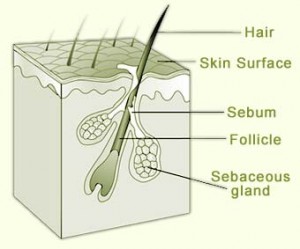
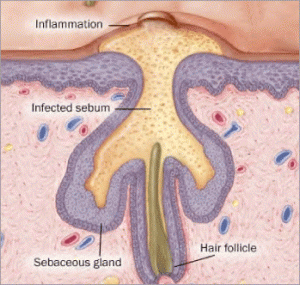
Picture 4 – Sebaceous Gland Picture 5 – Sebaceous Gland Inflammation
Source – fastacnerelief Source – skinstore-usa
Sebaceous Glands are one of the three kinds of sweat glands present in the skin. The other two are Eccrine and Apocrine glands.
References:
http://en.wikipedia.org/wiki/Sebaceous_gland
http://www.wisegeek.com/what-is-the-sebaceous-gland.htm
http://www.nlm.nih.gov/medlineplus/ency/article/000842.htm
http://www.doctorsofusc.com/condition/document/100537
http://www.upmc.com/healthatoz/pages/healthlibrary.aspx?chunkiid=100537

What r complications that may arise if we don’t remove a sebaceous cyst